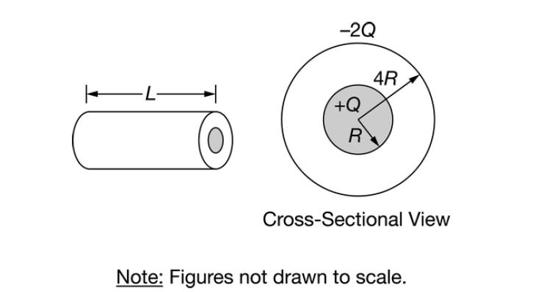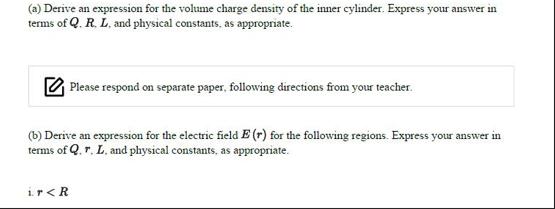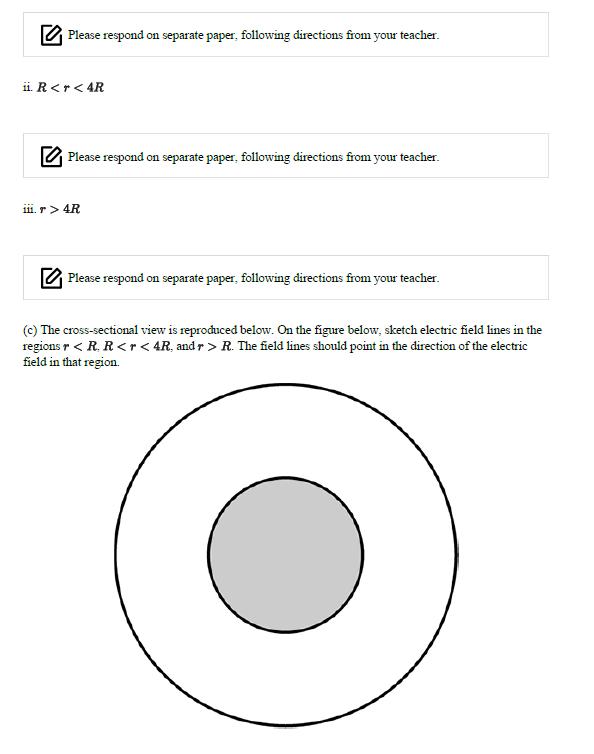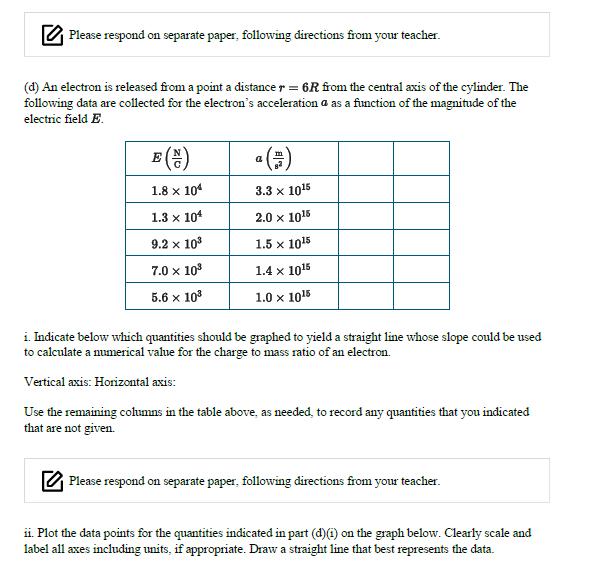Answered step by step
Verified Expert Solution
Question
1 Approved Answer
Al long, nonconducting cylinder of length L and radius R is placed along the axis of an infinitely long. very thin-walled conducting cylindrical shell






Al long, nonconducting cylinder of length L and radius R is placed along the axis of an infinitely long. very thin-walled conducting cylindrical shell of radius 4R. The charge on the inner cylinder is +Q and is uniformly distributed throughout its volume. The charge on the outer cylindrical shell is-2Q and is uniformly distributed along its length. -L-1 -2Q +Q R 4R Cross-Sectional View Note: Figures not drawn to scale. (a) Derive an expression for the volume charge density of the inner cylinder. Express your answer in terms of Q. R. L. and physical constants, as appropriate. Please respond on separate paper, following directions from your teacher. (b) Derive an expression for the electric field E (r) for the following regions. Express your answer in terms of Q. r. L. and physical constants, as appropriate. ir Please respond on separate paper, following directions from your teacher. ii. R 4R teacher. Please respond on separate paper, following directions from your teacher. (c) The cross-sectional view is reproduced below. On the figure below, sketch electric field lines in the regions r < R. R R. The field lines should point in the direction of the electric field in that region. Please respond on separate paper, following directions from your teacher. (d) An electron is released from a point a distance r = 6R from the central axis of the cylinder. The following data are collected for the electron's acceleration a as a function of the magnitude of the electric field E. 1.8 x 104 1.3 x 104 9.2 x 10 7.0 x 10 5.6 x 10 a 3.3 x 1015 2.0 x 1015 1.5 x 1015 1.4 x 1015 1.0 x 105 i. Indicate below which quantities should be graphed to yield a straight line whose slope could be used to calculate a numerical value for the charge to mass ratio of an electron. Vertical axis: Horizontal axis: Use the remaining columns in the table above, as needed, to record any quantities that you indicated that are not given. Please respond on separate paper, following directions from your teacher. ii. Plot the data points for the quantities indicated in part (d) (i) on the graph below. Clearly scale and label all axes including units, if appropriate. Draw a straight line that best represents the data. TT LL ++ LIL ELL IL ++ TTT 11 TT 111 TT LLL rrr 111 TT II TTT TTI Trr 111 LLL Frrr IL TT 111 LLI FFF TT: ||| LLL T T IE 144. ITE 111 tt HI LII FFF III -++ III TTT -ttt 111 LLU -FFF Please respond on separate paper, following directions from your teacher. +++ TT iii. Use the straight line graph to calculate a value for the charge to mass ratio of an electron Please respond on separate paper, following directions from your teacher.
Step by Step Solution
★★★★★
3.41 Rating (160 Votes )
There are 3 Steps involved in it
Step: 1
Here are the stepbystep workings and responses to the questions on a separate sheet of paper a Deriv...
Get Instant Access to Expert-Tailored Solutions
See step-by-step solutions with expert insights and AI powered tools for academic success
Step: 2

Step: 3

Ace Your Homework with AI
Get the answers you need in no time with our AI-driven, step-by-step assistance
Get Started


